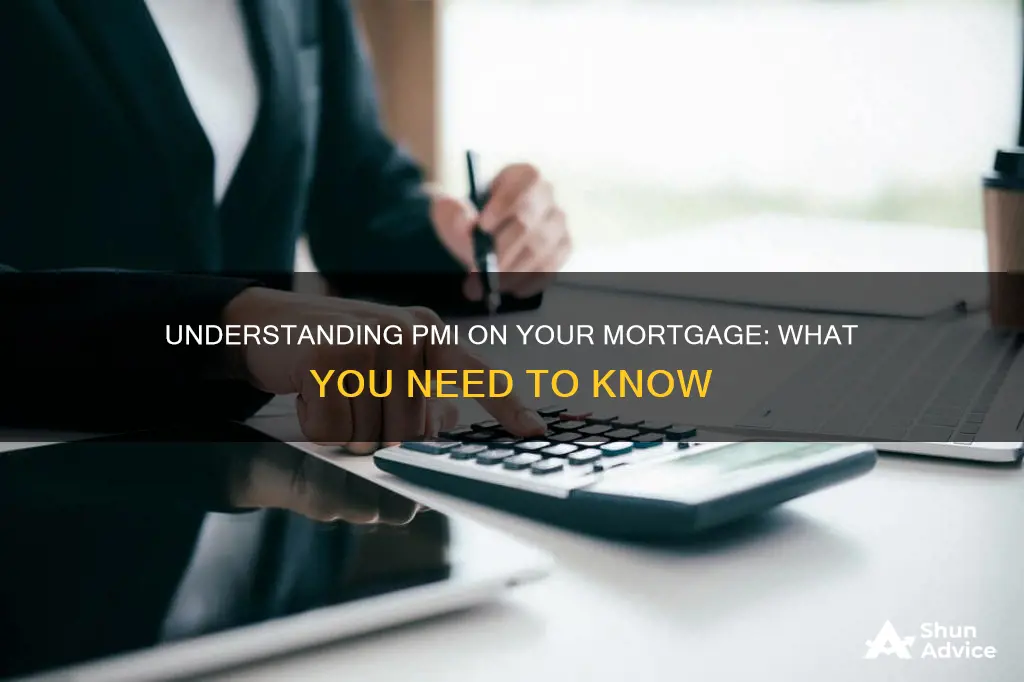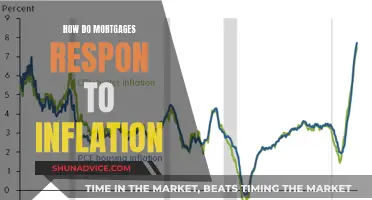
Private mortgage insurance (PMI) is a type of insurance that you may be required to pay if you don't have a 20% down payment for a conventional home loan. PMI is calculated based on several factors, including the size of your loan, your down payment amount, credit score, debt-to-income ratio, and loan-to-value ratio. The average cost of PMI ranges from 0.22% to 2.25% of the original loan amount per year, but can be higher or lower depending on individual circumstances. PMI protects the lender in the event that you default on your loan, but it can also offer benefits to borrowers, such as helping them qualify for a conventional loan. There are several ways to calculate PMI, and various payment methods are available.
| Characteristics | Values |
|---|---|
| Required down payment | 20% |
| Average PMI costs | Between 0.22% and 2.25% of your mortgage |
| Average cost of PMI for a conventional home loan | 0.46% to 1.50% of the original loan amount per year |
| Factors that influence PMI rates | Credit score, debt-to-income ratio, loan-to-value ratio, size of the loan |
| Types of PMI | Borrower-paid PMI (BPMI), Lender-paid PMI (LPMI), Single-premium PMI |
What You'll Learn

PMI is required when a down payment is less than 20%
PMI, or Private Mortgage Insurance, is an insurance policy that is required when a down payment on a home is less than 20%. It is an added cost that homebuyers must pay and it protects the lender in the event that the borrower defaults on the loan. This allows lenders to take on the additional risk of accepting smaller down payments, giving more people the opportunity to become homeowners.
The amount paid for PMI depends on several factors, including the size of the loan, the down payment amount, debt-to-income ratio, and credit score. The average cost of PMI for a conventional home loan ranges from 0.46% to 1.50% of the original loan amount per year, according to the Urban Institute's Housing Finance Policy Center. For example, PMI on a $300,000 mortgage would cost $1,380 to $4,500 per year, or $115 to $375 per month. Borrowers with lower credit scores, high debt-to-income ratios, and smaller down payments will typically pay higher PMI rates.
There are a few ways to avoid paying PMI without a 20% down payment. One option is lender-paid PMI, where the lender covers PMI costs in exchange for a higher interest rate on the mortgage. Another option is a piggyback loan, where a second mortgage is used to finance part of the down payment to avoid PMI. Additionally, veterans can avoid PMI without any down payment through the VA loan program.
TIAA Mortgages: A Comprehensive Comparison Guide
You may want to see also

PMI costs depend on credit score, debt-to-income ratio, and loan-to-value ratio
The cost of Private Mortgage Insurance (PMI) depends on several factors, including the size of your loan, your down payment amount, debt-to-income ratio, credit score, and loan-to-value (LTV) ratio.
Firstly, let's look at the role of credit score in determining PMI costs. A higher credit score will generally result in a lower PMI premium. This is because borrowers with higher credit scores are considered lower-risk by lenders. The PMI rate varies with credit score, with borrowers with lower credit scores paying more for PMI than those with higher scores. It is recommended that you aim for a credit score of 740 to 760 or higher to secure the best PMI rates.
Next, the debt-to-income (DTI) ratio is a significant factor in determining PMI costs. The DTI ratio represents the percentage of your income that goes towards paying off debts. Unlike credit scores, there are no different ranges for DTI ratios; everyone with a DTI ratio above 45% will pay the same PMI rate. Therefore, it is advisable to aim for a DTI ratio of 45% or lower to obtain the most favourable PMI rates.
Finally, the loan-to-value (LTV) ratio also influences PMI costs. The LTV ratio measures the percentage of the home's purchase price or value that you are borrowing. A higher LTV ratio, indicating a smaller down payment, will result in a higher PMI rate. Lenders typically prefer an LTV ratio of 80% or lower, so it is beneficial to aim for this ratio or lower to secure the best PMI rates.
In summary, borrowers with high credit scores, low DTIs, and larger down payments will generally pay lower PMI rates. It is important to consider these factors when applying for a mortgage to ensure you obtain the most favourable PMI rates and reduce your overall costs.
The Texas Mortgage Conundrum: How Do They Afford It?
You may want to see also

PMI is paid monthly, upfront, or both
Private mortgage insurance (PMI) is typically paid monthly, but it can also be paid upfront or through a combination of upfront and monthly payments.
Monthly PMI
Also known as borrower-paid mortgage insurance (BPMI), this is the most common PMI choice. The premium is based on a percentage of your loan balance and is added to your monthly payment. This option is usually chosen by borrowers as it allows them to spread out the cost.
Upfront PMI
Also called "single-premium PMI", this option allows you to pay the entire premium in one lump sum at the closing of your mortgage. This results in a lower monthly payment but requires a significant amount of cash upfront.
Split PMI
The split option combines the monthly and single premium options, allowing you to pay a portion of the PMI upfront and add the remaining balance to your monthly payments. This can be a good choice if you want to reduce your monthly expenses but don't have enough cash to pay the full upfront premium.
The decision on whether to pay PMI upfront or monthly depends on your financial situation and cash flow. Paying PMI upfront will lower your monthly mortgage payments, while paying it monthly preserves your cash savings for future expenses or emergencies. Additionally, if you have high credit scores, you may be able to secure a lower monthly PMI cost even with a minimum down payment.
Annuity Applications: Solving Mortgage Problems
You may want to see also

PMI is calculated by multiplying loan amount by PMI percentage
Private Mortgage Insurance (PMI) is an insurance policy that you pay when you take out a mortgage loan without committing to at least a 20% down payment. Most conventional lenders require a down payment of at least 20% of the purchase price. The insurance pays the lender a portion of the balance due in the event that you default on the loan. This enables lenders to take on the additional risk of accepting smaller down payments and gives more people the opportunity to become homeowners.
PMI rates vary based on your loan-to-value ratio, your credit score, and the lender concerned. The amount you'll pay for PMI depends on several factors, including the size of your loan, your down payment amount, debt-to-income ratio, and credit score. The larger your down payment, the less your PMI will cost. Those with higher credit scores and lower debt-to-income ratios typically pay lower rates as well. The average cost of PMI for a conventional home loan ranges from 0.46% to 1.50% of the original loan amount per year, according to the Urban Institute's Housing Finance Policy Center. The PMI cost varies depending on the loan amount, the lender, your credit score, and the percentage of the home's price that's left for you to pay.
To calculate your PMI payments, simply multiply your total loan amount by your PMI percentage. The result is your annual premium. Divide this number by 12 to calculate your estimated monthly payment, though remember that this number will be added to your mortgage premiums. For example, if your home’s total value is $270,000 and you put down $20,000, your mortgage amount will be $250,000. You can calculate your PMI range by multiplying this number by the upper and lower limit.
Understanding Negative Equity: Underwater on Your Mortgage
You may want to see also

PMI can be avoided by a 20% down payment
PMI, or Private Mortgage Insurance, is an insurance policy that protects the lender in the event of a borrower defaulting on their loan. It is typically required when a borrower makes a down payment of less than 20% on a conventional home loan. This is because a smaller down payment increases the risk for the lender.
The amount you pay for PMI depends on several factors, including the size of your loan, your down payment amount, debt-to-income ratio, and credit score. Generally, the larger the down payment, the less your PMI will cost. This is because it will take less time to reach 20% equity in your home, at which point PMI is no longer required for conventional mortgages.
If you can make a 20% down payment on your home loan, you can avoid paying PMI altogether. This is the most common way to eliminate PMI costs. However, it is not the only way, and there are other strategies you can explore if you cannot afford a 20% down payment. For example, you can look into lender-paid mortgage insurance (LPMI), where the lender covers PMI costs in exchange for a higher interest rate on the mortgage. You can also consider special first-time homebuyer loans, which do not require PMI. Additionally, if you are a veteran or active-duty service member, you may be eligible for a VA loan, which does not require PMI and offers favourable interest rates and terms.
Another option to avoid PMI without a 20% down payment is to take out a piggyback second mortgage, also known as an 80/10/10 agreement. This involves taking out two mortgages instead of one, with the second mortgage being used to fulfil the down payment requirements. For example, if you want to purchase a $200,000 house and can only afford a 10% down payment ($20,000), you can take out a first loan of $160,000 (80% of the total value) and a second loan of $20,000 (10% of the total value), and then put down your $20,000 cash (the remaining 10%). By splitting up the loans, you can avoid PMI altogether, but be aware that piggyback loans often have riskier terms, such as adjustable rates or shorter repayment periods.
In summary, while a 20% down payment is the most straightforward way to avoid PMI, there are other options available if you cannot afford this. It is important to carefully consider the financial implications of each option and choose the one that best suits your circumstances.
Renting vs. Mortgaging: The Equity Factor
You may want to see also
Frequently asked questions
PMI stands for Private Mortgage Insurance. It is a type of insurance that the borrower may have to pay if they don’t have 20% for a down payment. It protects the lender in case the borrower defaults on the loan.
The amount you'll pay for PMI depends on several factors, including the size of your loan, your down payment amount, debt-to-income ratio, and credit score. To calculate your PMI payments, multiply your total loan amount by your PMI percentage to get your annual premium. Divide this number by 12 to get your estimated monthly payment.
You can avoid paying PMI by making a 20% down payment. This is the best way to avoid PMI as it is usually required when an individual makes a down payment of less than 20%.







